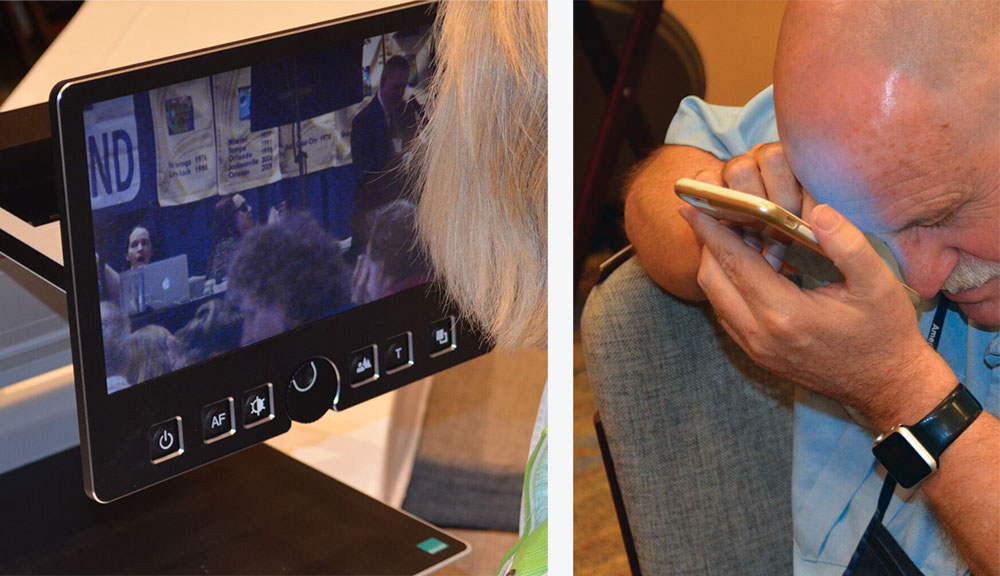The American Council of the Blind (ACB) is comprised of approximately 70 state chapters and special-interest affiliates representing a diverse range of groups within the blind community, including students, families, teachers, attorneys, governmental employees, entrepreneurs, vending stand operators and the LGBTQ community.
Several of these organizations, including the state chapters in Missouri and California, pre-date the founding of the ACB itself. This mix of national, state and local grass-roots organizations has helped ACB to create an organizational culture that values acceptance, peer support, diversity, democracy and direct action.
During its nearly 60-year history, ACB has become a leader in national, state, local and even international advocacy efforts. Some of ACB’s advocacy accomplishments have included:

- Providing direct advocacy and support for hallmark U.S. legislation which has contributed to the independence, dignity and economic opportunities of blind and visually impaired Americans for more than 50 years. Examples include: the Civil Rights Act of 1964, the Rehabilitation Act of 1973, the Air Carrier Access Act of 1986, the Fair Housing Act of 1988, the Americans with Disabilities Act of 1990, the 21st Century Communications and Video Accessibility Act, and many, many more.
- Partnering with national and international organizations to promote the independence of and economic security for blind and visually impaired people throughout the world. Efforts have included working side by side with the Disability Rights Education and Defense Fund (https://dredf.org/) and others to advocate for the U.S. to adopt the UN Convention on the Rights of Persons with Disabilities (UNCRPD), active participation in the World Blind Union (www.worldblindunion.org) since its founding in 1984 and the funding of annual participation from international organizations and speakers at each year’s ACB conference and convention.
- Assisting state chapters, national special-interest affiliates, local chapters and individual members with the resolution of access issues that impact blind and visually impaired people every day. Examples include support of several blind and visually impaired Californians and ACB’s California state chapter to address access to automated teller machines (ATMs), bank statements and other financial services, participation in negotiated settlements with a number of companies resulting in access improvements in areas as diverse as the accessibility of drug labels, the usability of point-of-sale equipment at supermarkets, and the accessibility of program materials distributed by organizations like Weight Watchers and the American Cancer Society.
- Working directly with major companies to improve the accessibility and usability of their products and services by people who are blind or visually impaired. Examples include: Microsoft Corporation, Google, Apple, Comcast Cable, Cox Communications, and many others.
- Developing topical resources which are helping to drive improvements in areas as diverse as the accessibility of the pedestrian environment, the safety of quiet cars, the usability of adaptive technology and much more. Building on this history, the ACB is striving to lead local, national and world blindness advocacy efforts for many years to come.
Current goals of the organization include:
- Working with major technology vendors to ensure that the information and communication technology of the future is accessible to and usable by people who are blind or visually impaired, regardless of how and why they access their technology.
- Partnering with municipalities, transit authorities, transportation companies, architectural and engineering firms, planners and other organizations and individuals to design and build an infrastructure (including sidewalks, streetscapes and transportation services) that is intuitive and accessible for everyone — including people who are blind or visually impaired.
- Collaborating with parents, educators and other professionals and organizations to ensure that blind and visually impaired children receive the same educational opportunities in the most appropriate setting and using the most appropriate tools possible so that no child is ever left behind because of his or her visual acuity. This includes an unwavering support for both emerging technologies and braille — the only written form of language that is truly accessible for people who are blind.
- Striving in all areas of life to promote the equal participation of blind and visually impaired people in all areas of social and civic life — from signing up for a dance lesson, to taking a cooking class, to attending college, to serving on a jury, to casting a secret ballot in a national election, to holding public office.
